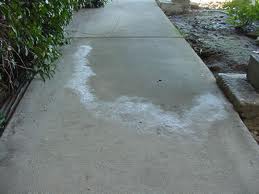Concrete Efflorescence
Why does this white powdery substance appear on concrete and how do you remove it?
What causes efflorescence on concrete floors and walls?
Concrete efflorescence is a very common problem on concrete, especially decorative concrete. When moisture and water vapor migrate to the surface of hardened concrete floors, walls, and colored concrete, it carries with it calcium hydroxide. Calcium hydroxide or "lime" is formed by the hydration reaction between portland cement and water. When the calcium hydroxide reaches the surface of the concrete, it combines with carbon dioxide in the air to produce calcium carbonate or efflorescence.

This dusty, white salt like substance can show up immediately after the concrete has hardened or sometimes take days or weeks to present itself. Water is the key to triggering the reaction. A moist sub-grade, excessive water in the mix, water thrown on the surface to assist troweling, rain, or moist cool temperatures are some conditions that can contribute to efflorescence.
Efflorescence can also show up on concrete surfaces in the forms of sodium & potassium (hydroxide and sulfates). These salts are much more soluble in water than calcium and they form efflorescence sooner than calcium hydroxide does. These kinds of salts can come from cement, aggregates, admixtures, and water.
How to remove concrete efflorescence
The simplest way to remove efflorescence on concrete is catching it at its earliest stage, before it combines with carbon dioxide. At this time it can be removed by lightly scrubbing or pressure washing the concrete with water and rinsing the calcium hydroxide away. Be careful to use fresh water and don't leave any residue behind, you can wet-vac or use a leaf blower to remove any standing water from the surface. Any leftover residue will cause new efflorescence to show up.
If the efflorescence doesn't rinse off with water, you can try a mild acid solution. Vinegar, citric acid, and muriatic acid are popular choices to try
when the efflorescence becomes more difficult to remove. Muriatic acid comes in full strength and has to be diluted with water, if you decide to use this product take the proper precautions and read the instructions on the bottle carefully. Usually 10 parts water to 1 part acid solution is sufficient. Always test in an area that will be hidden if possible.
Once you've acid washed and lightly scrubbed the concrete, you have to neutralize the acid with a mixture of baking soda or ammonia and water (9 parts water to 1 part baking soda or ammonia). Mop or spray this solution on the surface of the concrete, lightly scrub it around, and rinse or wet-vac it off the concrete.
Some companies sell their own concrete efflorescence remover. These products contain an acidic solution that isn't muriatic acid making them a little safer to use. Most of these efflorescence removers still require diluting, neutralizing, and rinsing the concrete.
To avoid efflorescence on concrete, a vapor barrier should be used under the concrete and a concrete sealer should be used on the surface. These two things, if done right, will keep water from entering the concrete from the top and bottom. Without the constant pressure of water vapor migrating to the surface, efflorescence can be minimized or avoided altogether.
Radonseal has an environmentally safe concrete efflorescence remover.
You can pruchase this right from their web-site. The price is $199.00 for 5 gallons or $109.00 for 2.5 gallons. It doesn't contain any acid, making it much safer to use.
Return from Concrete Efflorescence to Epoxy Concrete Repair
Return from Concrete Efflorescence to Everything About Concrete Home Page














